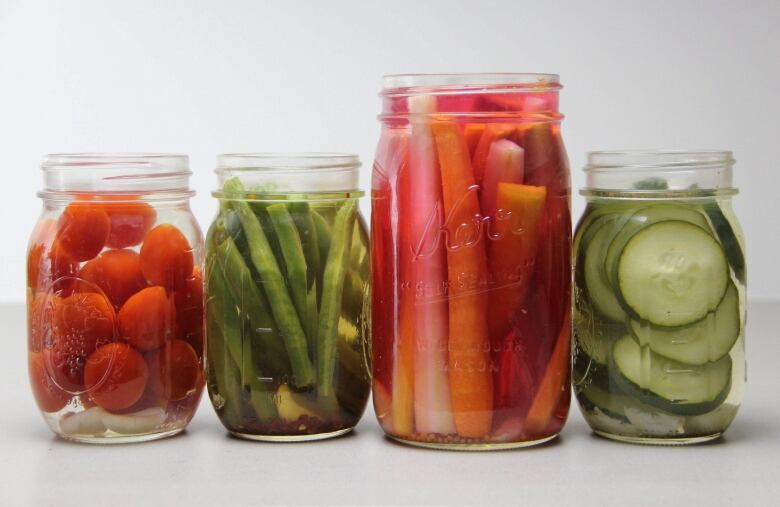Pickles enjoying Renaissance, and they can be DIY: Andrew Coppolino

A few thousand years ago, Cleopatra believed that eating pickles would enhance her beauty. While she was a devotee of the preserved little cucumbers, the Egyptian queen likely didn't experience a cosmetic benefit, but it does indicate just how long the foodstuff and the culinary technique of pickling has been with us.
Today, it's safe to say that pickles are popular and perhaps more so than ever. Restaurants inspired by the local food movement and the impetus to create crafted, artisanal foods include them frequently in a variety of dishes. And the range of pickles itself is quite extraordinary, if you hear chef Jason Hanoski of Kitchener's Grand Trunk Saloon describe it.
- More food stories from Andrew Coppolino
- Farm gate stands offer fresh produce and nostalgia
- Top summer picnic spots around Waterloo region
"Pickling is a big thing in this house, so we've got pickled watermelon, pickled cactus, pickled quail eggs, pickled chilies of all kinds and pickled onions on our regular menu. We pickle fresh new things pretty much every week for our features," Hanoski said.
In Waterloo, Nick Benninger of Marbles Restaurant suggests charring some asparagus when it's in season and pickling it in a basic solution of cider vinegar, shallots, coriander, honey and jalapenos.
"Pour a cold beer, cut up some hard Cheddar cheese and find a shady tree to sit under and enjoy," Benninger said.
One of the great things about pickling year-round but especially during the bounty of the summer months is that pickling allows you to enjoy foods several months later when they are no longer in season.

Pickles: a process and product
A pickle is both a process and a product, only one example of which is the crispy, vinegary little cucumbers that we eat with our sandwiches. Pickling is submerging a foodstuff (vegetables, fruits, eggs, cheese, meat, fish) in a salt, or salt-and-sugar brine solution or in a strong acid such as vinegar (which is itself made from a fermentation process) in order to preserve it.
Fermenting and pickling are allied techniques, and both are ancient.The jars of pickles in the grocery store aisle are pasteurized and shelf-stable and are not fermented (but must be refrigerated after opening). The jars of pickles that reside in cooler cases, often with the sandwich meats that they accompany, have undergone some fermentation; however, the true fermented pickle that you pulled out of a barrel of brine of the past is a rarity these days.
Just as we say "all Cognac is brandy, but not all brandy is Cognac," we can say that all ferments are in a sense pickled, but not all pickles are fermented. The fermentation process creates an acidic environment in which starches and sugars in the food are converted into lactic acid which keeps at bay the "bad" bacteria.

Pickles can be quick and easy
The formal canning process to make young cucumbers into pickles is a somewhat arduous chore that involves boiling water baths and special equipment that needs to be sterilized, terms such as "head space" and making sure the jars are securely and safely sealed.
However, it's relatively easy to make what are called quick refrigerator pickles: with your ingredients lined up and ready to go, you can put together a quick pickle for the refrigerator in about the time it takes to boil water.
Regardless of what you are pickling, according to the pros, you are going to have to be liberal with some of the ingredients, it should be noted, so don't be shy, advises Hanoski.
"You're probably going to use a little bit more salt and more sugar than you are expecting, but that is quite okay," he said. "Go for those nice big, bold flavours in some nice big, bold vegetables."
Quick sweet refrigerator pickles
Ingredients
- 3 cups of cucumbers, sliced into coins
- cup white onion, thinly sliced
- cup red onion, thinly sliced
- 1-2 garlic cloves, sliced (depending on desired garlic level)
- 1 tablespoons pickling salt
- 1 cups of apple cider vinegar
- 1 - 2 cups white sugar (depending on desired sweetness)
- tablespoon whole mustard seeds
- 1 teaspoon turmeric
- 1 teaspoon celery seed
- 2 whole peppercorns
- 2 whole cloves
Method
Rinse out your jar with boiling water and keep clean.
Pack cucumbers, onions and garlic into the jar. In a saucepan, combine the salt, vinegar, sugar and remaining ingredients and bring to a gentle boil, stirring occasionally to make sure sugar and salt have dissolved.
Pour the vinegar mixture into the jar of cucumbers and make sure they are covered with the liquid. Secure the jar lid and put into the refrigerator. Ideally, refrigerate about five days before trying the pickles. They can be stored in the refrigerator for about eight months.












_(720p).jpg)


 OFFICIAL HD MUSIC VIDEO.jpg)
.jpg)



























































































